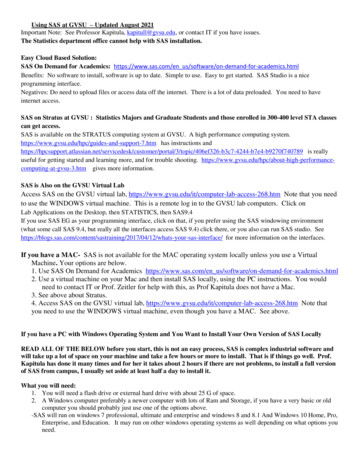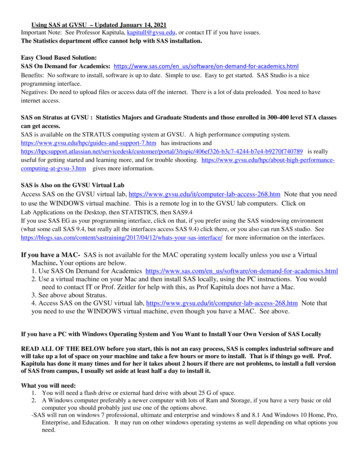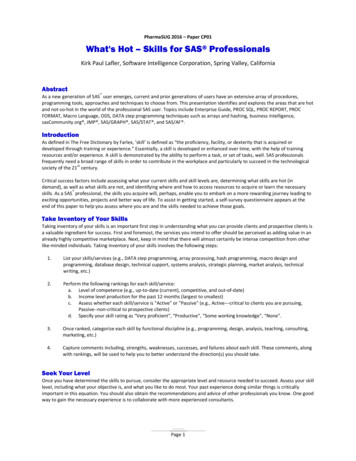
Transcription
SAS/OR 15.1 User’s GuideMathematical ProgrammingThe QuadraticProgramming Solver
This document is an individual chapter from SAS/OR 15.1 User’s Guide: Mathematical Programming.The correct bibliographic citation for this manual is as follows: SAS Institute Inc. 2018. SAS/OR 15.1 User’s Guide: MathematicalProgramming. Cary, NC: SAS Institute Inc.SAS/OR 15.1 User’s Guide: Mathematical ProgrammingCopyright 2018, SAS Institute Inc., Cary, NC, USAAll Rights Reserved. Produced in the United States of America.For a hard-copy book: No part of this publication may be reproduced, stored in a retrieval system, or transmitted, in any form or byany means, electronic, mechanical, photocopying, or otherwise, without the prior written permission of the publisher, SAS InstituteInc.For a web download or e-book: Your use of this publication shall be governed by the terms established by the vendor at the timeyou acquire this publication.The scanning, uploading, and distribution of this book via the Internet or any other means without the permission of the publisher isillegal and punishable by law. Please purchase only authorized electronic editions and do not participate in or encourage electronicpiracy of copyrighted materials. Your support of others’ rights is appreciated.U.S. Government License Rights; Restricted Rights: The Software and its documentation is commercial computer softwaredeveloped at private expense and is provided with RESTRICTED RIGHTS to the United States Government. Use, duplication, ordisclosure of the Software by the United States Government is subject to the license terms of this Agreement pursuant to, asapplicable, FAR 12.212, DFAR 227.7202-1(a), DFAR 227.7202-3(a), and DFAR 227.7202-4, and, to the extent required under U.S.federal law, the minimum restricted rights as set out in FAR 52.227-19 (DEC 2007). If FAR 52.227-19 is applicable, this provisionserves as notice under clause (c) thereof and no other notice is required to be affixed to the Software or documentation. TheGovernment’s rights in Software and documentation shall be only those set forth in this Agreement.SAS Institute Inc., SAS Campus Drive, Cary, NC 27513-2414November 2018SAS and all other SAS Institute Inc. product or service names are registered trademarks or trademarks of SAS Institute Inc. in theUSA and other countries. indicates USA registration.Other brand and product names are trademarks of their respective companies.SAS software may be provided with certain third-party software, including but not limited to open-source software, which islicensed under its applicable third-party software license agreement. For license information about third-party software distributedwith SAS software, refer to http://support.sas.com/thirdpartylicenses.
Chapter 12The Quadratic Programming SolverContentsOverview: QP Solver . . . . . . . . . . . . . . . . . . . . . . . . . . . . . . . . . . . . . .596Getting Started: QP Solver . . . . . . . . . . . . . . . . . . . . . . . . . . . . . . . . . . .597Syntax: QP Solver . . . . . . . . . . . . . . . . . . . . . . . . . . . . . . . . . . . . . . .600Functional Summary . . . . . . . . . . . . . . . . . . . . . . . . . . . . . . . . . . .600QP Solver Options . . . . . . . . . . . . . . . . . . . . . . . . . . . . . . . . . . . .601Details: QP Solver . . . . . . . . . . . . . . . . . . . . . . . . . . . . . . . . . . . . . . .Interior Point Algorithm: Overview . . . . . . . . . . . . . . . . . . . . . . . . . . .603603Parallel Processing . . . . . . . . . . . . . . . . . . . . . . . . . . . . . . . . . . . .605Iteration Log . . . . . . . . . . . . . . . . . . . . . . . . . . . . . . . . . . . . . . .605Problem Statistics . . . . . . . . . . . . . . . . . . . . . . . . . . . . . . . . . . . .605Irreducible Infeasible Set . . . . . . . . . . . . . . . . . . . . . . . . . . . . . . . .606Macro Variable OROPTMODEL . . . . . . . . . . . . . . . . . . . . . . . . . . .607Examples: QP Solver . . . . . . . . . . . . . . . . . . . . . . . . . . . . . . . . . . . . . .608Example 12.1: Linear Least Squares Problem . . . . . . . . . . . . . . . . . . . . . .609Example 12.2: Portfolio Optimization . . . . . . . . . . . . . . . . . . . . . . . . . .611Example 12.3: Portfolio Selection with Transactions . . . . . . . . . . . . . . . . . .615References . . . . . . . . . . . . . . . . . . . . . . . . . . . . . . . . . . . . . . . . . . .618
596 F Chapter 12: The Quadratic Programming SolverOverview: QP SolverThe OPTMODEL procedure provides a framework for specifying and solving quadratic programs.Mathematically, a quadratic programming (QP) problem can be stated as follows:minsubject to12xT Qx C cT xAx f ; D; g bl x uwhereQAxcblu2222222Rn nRm nRnRnRmRnRnis the quadratic (also known as Hessian) matrixis the constraints matrixis the vector of decision variablesis the vector of linear objective function coefficientsis the vector of constraints right-hand sides (RHS)is the vector of lower bounds on the decision variablesis the vector of upper bounds on the decision variablesThe quadratic matrix Q is assumed to be symmetric; that is,qij D qj i ;8i; j D 1; : : : ; nIndeed, it is easy to show that even if Q 6D QT , the simple modificationQ D 1 .Q C QT /Q2Q hence symmetry is assumed. When you specify aproduces an equivalent formulation xT Qx xT QxIquadratic matrix, it suffices to list only lower triangular coefficients.In addition to being symmetric, Q is also required to be positive semidefinite for minimization type of models:xT Qx 0;8x 2 RnQ is required to be negative semidefinite for maximization type of models. Convexity can come as a result ofa matrix-matrix multiplicationQ D LLTor as a consequence of physical laws, and so on. See Figure 12.1 for examples of convex, concave, andnonconvex objective functions.The order of constraints is insignificant. Some or all components of l or u (lower and upper bounds,respectively) can be omitted.
Getting Started: QP Solver F 597Figure 12.1 Examples of Convex, Concave, and Nonconvex Objective FunctionsGetting Started: QP SolverConsider a small illustrative example. Suppose you want to minimize a two-variable quadratic functionf .x1 ; x2 / on the nonnegative quadrant, subject to two constraints:min 2x1 C 3x2subject to x1x2x1 C 2x2x1x2C x12 C 10x22 C 2:5x1 x2 1 100 0 0To use the OPTMODEL procedure, it is not necessary to fit this problem into the general QP formulationmentioned in the section “Overview: QP Solver” on page 596 and to compute the corresponding parameters.However, since these parameters are closely related to the data set that is used by the OPTQP procedureand has a quadratic programming system (QPS) format, you can compute these parameters as follows. Thelinear objective function coefficients, vector of right-hand sides, and lower and upper bounds are identifiedimmediately as 210C1cD; bD; lD; uD31000C1Carefully construct the quadratic matrix Q. Observe that you can use symmetry to separate the main-diagonaland off-diagonal elements:nnX1 T1 X1Xx Qx xi qij xj Dqi i xi2 Cxi qij xj222i;j D1i D1i j
598 F Chapter 12: The Quadratic Programming SolverThe first expressionn1Xqi i xi22i D1sums the main-diagonal elements. Thus, in this case you haveq11 D 2;q22 D 20Notice that the main-diagonal values are doubled in order to accommodate the 1/2 factor. Now the secondtermXxi qij xji jsums the off-diagonal elements in the strict lower triangular part of the matrix. The only off-diagonal(xi xj ; i 6D j ) term in the objective function is 2:5 x1 x2 , so you haveq21 D 2:5Notice that you do not need to specify the upper triangular part of the quadratic matrix.Finally, the matrix of constraints is as follows: 11AD12The following OPTMODEL program formulates the preceding problem in a manner that is very close to themathematical specification of the given problem:/* getting started */proc optmodel;var x1 0; /* declare nonnegative variable x1 */var x2 0; /* declare nonnegative variable x2 *//* objective: quadratic function f(x1, x2) */minimize f /* the linear objective function coefficients */2 * x1 3 * x2 /* quadratic x, Qx */x1 * x1 2.5 * x1 * x2 10 * x2 * x2;/* subject to the following constraints */con r1: x1 - x2 1;con r2: x1 2 * x2 100;/* specify iterative interior point algorithm (QP)* in the SOLVE statement */solve with qp;/* print the optimal solution */print x1 x2;save qps qpsdata;quit;The “with qp” clause in the SOLVE statement invokes the QP solver to solve the problem. The output isshown in Figure 12.2.
Getting Started: QP Solver F 599Figure 12.2 Summaries and Optimal SolutionThe OPTMODEL ProcedureProblem SummaryObjective SenseMinimizationObjective FunctionfObjective TypeQuadraticNumber of Variables2Bounded Above0Bounded Below2Bounded Below and Above0Free0Fixed0Number of Constraints2Linear LE ( )1Linear EQ ( )0Linear GE ( )1Linear Range0Constraint Coefficients4Hessian Diagonal Elements2Hessian Elements Below Diagonal1Solution SummarySolverQPAlgorithmInterior PointObjective FunctionfSolution StatusOptimalObjective Value15018.000046Primal Infeasibility0Dual Infeasibility0Bound InfeasibilityDuality e Time0.00Solution Time0.04x1 x234 33In this example, the SAVE QPS statement is used to save the QP problem in the QPS-format data set qpsdata,shown in Figure 12.3. The data set is consistent with the parameters of general quadratic programmingpreviously computed. Also, the data set can be used as input to the OPTQP procedure.
600 F Chapter 12: The Quadratic Programming SolverFigure 12.3 QPS-Format Data SetObs FIELD1FIELD2 FIELD3 FIELD4 FIELD5 FIELD61 NAMEqpsdata2 ROWS.3 Nf.4 Lr1.5 Gr2.6 COLUMNS.7x1f2.0 r118x1r21.0.9x2f3.0 r110x2r22.0.11 RHS-112.RHS.r11.0.13.RHS.r2100.0.14 QSECTION15x1x12.0.16x1x22.5.17x2x220.0.18 ENDATASyntax: QP SolverThe following statement is available in the OPTMODEL procedure:SOLVE WITH QP / options ;Functional SummaryTable 12.1 summarizes the list of options available for the SOLVE WITH QP statement, classified by function.Table 12.1 Options for the QP SolverDescriptionSolver OptionsEnables or disables IIS detectionControl OptionsSpecifies the stopping criterion based on duality gapSpecifies the dual feasibility toleranceSpecifies how often to print the solution progressSpecifies the maximum number of iterationsSpecifies the time limit for the optimization processSpecifies the maximum number of threadsSpecifies the type of presolveSpecifies the primal feasibility toleranceSpecifies units of CPU time or real timeOptionIIS DUALITYGAP DUALTOL LOGFREQ MAXITER MAXTIME NTHREADS PRESOLVER PRIMALTOL TIMETYPE
QP Solver Options F 601QP Solver OptionsThis section describes the options recognized by the QP solver. These options can be specified after a forwardslash (/) in the SOLVE statement, provided that the QP solver is explicitly specified using a WITH clause.The QP solver does not provide an intermediate solution if the solver terminates before reaching optimality.DUALITYGAP ıspecifies the desired relative duality gap, ı 2 [1E–9, 1E–4]. This is the relative difference betweenthe primal and dual objective function values and is the primary solution quality parameter. For moreinformation, see the section “Interior Point Algorithm: Overview” on page 603. The default value is1E–6.DUALTOL ˇOPTTOL ˇspecifies the maximum relative dual constraints violation, ˇ 2 [1E–9, 1E–4]. For more information,see the section “Interior Point Algorithm: Overview” on page 603. The default value is 1E–6.IIS FALSE j TRUEspecifies whether to attempt to identify a set of constraints and variables that form an irreducibleinfeasible set (IIS). You can specify the following values:FALSEdisables IIS detection.TRUEenables IIS detection.If an IIS is found, you can find information about the infeasibilities in the .status values of theconstraints and variables. For more information about this option, see the section “Irreducible InfeasibleSet” on page 606. For more information about the .status suffix, see the section “Suffixes” on page 135.By default, IIS FALSE.LOGFREQ kPRINTFREQ kprints the solution progress to the iteration log after every k iterations, where k is an integer between 0and the largest four-byte signed integer, which is 231 1. The value k 0 suppresses printing of theprogress of the solution. By default, LOGFREQ 1.MAXITER kspecifies the maximum number of iterations, where k can be any integer between 1 and the largestfour-byte signed integer, which is 231 1. If you do not specify this option, the procedure does notstop based on the number of iterations performed.MAXTIME tspecifies an upper limit of t units of time for the optimization process, including problem generationtime and solution time. The value of the TIMETYPE option determines the type of units used. If youdo not specify the MAXTIME option, the solver does not stop based on the amount of time elapsed.The value of t can be any positive number; the default value is the positive number that has the largestabsolute value that can be represented in your operating environment.
602 F Chapter 12: The Quadratic Programming SolverNTHREADS kspecifies the number of threads that the QP solver can use, where k can be any integer between 1 and256, inclusive. The default is the value of the OPTMODEL NTHREADS option.Specifying k as a number greater than the actual number of available cores might result in reducedperformance. Specifying a high value for k does not guarantee shorter solution time; the actual changein solution time depends on the computing hardware and the scalability of the underlying algorithmsin the QP solver. In some circumstances, the QP solver might use fewer than k threads because thesolver’s internal algorithms have determined that a smaller number is preferable.PRESOLVER AUTOMATIC j NONE j BASIC j MODERATE j AGGRESSIVEspecifies the presolve level. You can specify the following values:AUTOMATICapplies the presolver by using the default setting.NONEdisables the presolver.BASICapplies the basic presolver.MODERATEapplies the moderate presolver.AGGRESSIVEapplies the aggressive presolver.By default, PRESOLVER AUTOMATIC.PRIMALTOL FEASTOL specifies the maximum relative bound and primal constraints violation, 2 [1E–9, 1E–4]. For moreinformation, see the section “Interior Point Algorithm: Overview” on page 603. The default value is1E–6.TIMETYPE CPU j REALspecifies the units of time used by the MAXTIME option and reported by the PRESOLVE TIME andSOLUTION TIME terms in the OROPTMODEL macro variable. You can specify the followingvalues:CPUspecifies that units are in CPU time.REALspecifies that units are in real time.The “Optimization Statistics” table, an output of the OPTMODEL procedure if you specify PRINTLEVEL 2 in the PROC OPTMODEL statement, also includes the same time units for Presolver Time,Solver Time, and other times (such as Problem Generation Time).The default value of the TIMETYPE option depends on the value of the NTHREADS option.Table 12.2 describes the detailed logic for determining the default; the first context in the table thatapplies determines the default value.Table 12.2 Default Value for TIMETYPE OptionContextSolver is invoked in an OPTMODEL COFOR loopNTHREADS value is greater than 1NTHREADS 1DefaultREALREALCPU
Details: QP Solver F 603Details: QP SolverInterior Point Algorithm: OverviewThe QP solver implements an infeasible primal-dual predictor-corrector interior point algorithm. To illustratethe algorithm and the concepts of duality and dual infeasibility, consider the following QP formulation (theprimal):min 21 xT Qx C cT xsubject to Ax bx 0The corresponding dual formulation is1 T2 x Qxmaxsubject toQxC bT yC AT y C w D cy 0w 0where y 2 Rm refers to the vector of dual variables and w 2 Rn refers to the vector of dual slack variables.The dual makes an important contribution to the certificate of optimality for the primal. The primal anddual constraints combined with complementarity conditions define the first-order optimality conditions, alsoknown as KKT (Karush-Kuhn-Tucker) conditions, which can be stated as follows where e .1; : : : ; 1/T ofappropriate dimension and s 2 Rm is the vector of primal slack variables:Ax sQx C AT y C wWXeSYex; y; w; sDDDD b .primal feasibility/c.dual feasibility/0 .complementarity/0 .complementarity/0N OTE : Slack variables (the s vector) are automatically introduced by the solver when necessary; it is thereforerecommended that you not introduce any slack variables explicitly. This enables the solver to handle slackvariables much more efficiently.The letters X; Y; W; and S denote matrices with corresponding x, y, w, and s on the main diagonal and zeroelsewhere, as in the following example:23x1 0 06 0 x2 0 767X 6 ::: : ::: 7:4 :: : 5:00 xnIf .x ; y ; w ; s / is a solution of the previously defined system of equations that represent the KKTconditions, then x is also an optimal solution to the original QP model.
604 F Chapter 12: The Quadratic Programming SolverAt each iteration the interior point algorithm solves a large, sparse system of linear equations, Y 1SA y„DATQ X 1W x‚where x and y denote the vector of search directions in the primal and dual spaces, respectively, and ‚and „ constitute the vector of the right-hand sides.The preceding system is known as the reduced KKT system. The QP solver uses a preconditioned quasiminimum residual algorithm to solve this system of equations efficiently.An important feature of the interior point algorithm is that it takes full advantage of the sparsity in theconstraint and quadratic matrices, thereby enabling it to efficiently solve large-scale quadratic programs.The interior point algorithm works simultaneously in the primal and dual spaces. It attains optimality whenboth primal and dual feasibility are achieved and when complementarity conditions hold. Therefore, it is ofinterest to observe the following four measures where kvk2 is the Euclidean norm of the vector v: relative primal infeasibility measure : DkAx b sk2kbk2 C 1 relative dual infeasibility measure ˇ:ˇDkQx C c AT ykck2 C 1wk2 relative duality gap ı:ıDjxT Qx C cT xbT yjj 12 xT Qx C cT xj C 1 absolute complementarity :DnXi D1xi wi CmXyi sii D1These measures are displayed in the iteration log.
Parallel Processing F 605Parallel ProcessingThe interior point algorithm can be run in single-machine mode (in single-machine mode, the computation isexecuted by multiple threads on a single computer).Iteration LogThe following information is displayed in the iteration log:Iterindicates the iteration number.Complementindicates the (absolute) complementarity.Duality Gapindicates the (relative) duality gap.Primal Infeasindicates the (relative) primal infeasibility measure.Bound Infeasindicates the (relative) bound infeasibility measure.Dual Infeasindicates the (relative) dual infeasibility measure.Timeindicates the time elapsed (in seconds).If the sequence of solutions converges to an optimal solution of the problem, you should see all columnsin the iteration log converge to zero or very close to zero. Nonconvergence can be the result of insufficientiterations being performed to reach optimality. In this case, you might need to increase the value that youspecify in the MAXITER or MAXTIME option. If the complementarity or the duality gap does notconverge, the problem might be infeasible or unbounded. If the infeasibility columns do not converge, theproblem might be infeasible.Problem StatisticsOptimizers can encounter difficulty when solving poorly formulated models. Information about datamagnitude provides a simple gauge to determine how well a model is formulated. For example, a modelwhose constraint matrix contains one very large entry (on the order of 109 ) can cause difficulty when theremaining entries are single-digit numbers. The PRINTLEVEL 2 option in the OPTMODEL procedurecauses the ODS table ProblemStatistics to be generated when the QP solver is called. This table providesbasic data magnitude information that enables you to improve the formulation of your models.The example output in Figure 12.4 demonstrates the contents of the ODS table ProblemStatistics.
606 F Chapter 12: The Quadratic Programming SolverFigure 12.4 ODS Table ProblemStatisticsThe OPTMODEL ProcedureProblem StatisticsNumber of Constraint Matrix Nonzeros4Maximum Constraint Matrix Coefficient2Minimum Constraint Matrix Coefficient1Average Constraint Matrix Coefficient1.25Number of Linear Objective Nonzeros2Maximum Linear Objective Coefficient3Minimum Linear Objective Coefficient2Average Linear Objective Coefficient2.5Number of Nonzeros Below Diagonal in the Hessian1Number of Diagonal Nonzeros in the Hessian2Maximum Hessian CoefficientMinimum Hessian CoefficientAverage Hessian CoefficientNumber of RHS NonzerosMaximum RHSMinimum RHSAverage RHS2026.752100150.5Maximum Number of Nonzeros per Column2Minimum Number of Nonzeros per Column2Average Number of Nonzeros per Column2Maximum Number of Nonzeros per Row2Minimum Number of Nonzeros per Row2Average Number of Nonzeros per Row2Irreducible Infeasible SetFor a quadratic programming problem, an irreducible infeasible set (IIS) is an infeasible subset of constraintsand variable bounds that becomes feasible if any single constraint or variable bound is removed. It is possibleto have more than one IIS in an infeasible QP. Identifying an IIS can help isolate the structural infeasibility ina QP. The IIS TRUE option directs the QP solver to search for an IIS in a specified QP.Whether a quadratic programming problem is feasible or infeasible is determined by its constraints andvariable bounds, which have nothing to do with its objective function. When you specify the IIS TRUEoption, the QP solver treats this problem as a linear programming problem by ignoring its objective function.Then finding IIS is the same as what the LP solver does with the IIS TRUE option. For more informationabout the irreducible infeasible set, see the section “Irreducible Infeasible Set” on page 275 in Chapter 7,“The Linear Programming Solver.”
Macro Variable OROPTMODEL F 607Macro Variable OROPTMODELThe OPTMODEL procedure always creates and initializes a SAS macro called OROPTMODEL . Thisvariable contains a character string. After each PROC OROPTMODEL run, you can examine this macro byspecifying %put & OROPTMODEL ; and check the execution of the most recently invoked solver from thevalue of the macro variable. The various terms of the variable after the QP solver is called are interpreted asfollows.STATUSindicates the solver status at termination. It can take one of the following values:OKThe solver terminated normally.SYNTAX ERRORIncorrect syntax was used.DATA ERRORThe input data were inconsistent.OUT OF MEMORYInsufficient memory was allocated to the procedure.IO ERRORA problem occurred in reading or writing data.SEMANTIC ERRORAn evaluation error, such as an invalid operand type, occurred.ERRORThe status cannot be classified into any of the preceding categories.ALGORITHMindicates the algorithm that produced the solution data in the macro variable. This term appears onlywhen STATUS OK. It can take the following value:IPThe interior point algorithm produced the solution data.IISThe IIS functionality produced the solution data.SOLUTION STATUSindicates the solution status at termination. It can take one of the following values:OPTIMALThe solution is optimal.CONDITIONAL OPTIMALThe solution is optimal, but some infeasibilities (primal,dual or bound) exceed tolerances due to scaling or preprocessing.INFEASIBLEThe problem is infeasible.UNBOUNDEDThe problem is unbounded.INFEASIBLE OR UNBOUNDEDThe problem is infeasible or unbounded.BAD PROBLEM TYPEThe problem type is unsupported by the solver.ITERATION LIMIT REACHEDThe maximum allowable number of iterations wasreached.TIME LIMIT REACHEDThe solver reached its execution time limit.FUNCTION CALL LIMIT REACHEDThe solver reached its limit on function evaluations.INTERRUPTEDThe solver was interrupted externally.
608 F Chapter 12: The Quadratic Programming SolverFAILEDThe solver failed to converge, possibly due to numericalissues.OBJECTIVEindicates the objective value obtained by the solver at termination.PRIMAL INFEASIBILITYindicates the (relative) infeasibility of the primal constraints at the solution. For more information, seethe section “Interior Point Algorithm: Overview” on page 603.DUAL INFEASIBILITYindicates the (relative) infeasibility of the dual constraints at the solution. For more information, seethe section “Interior Point Algorithm: Overview” on page 603.BOUND INFEASIBILITYindicates the (relative) violation by the solution of the lower or upper bounds (or both). For moreinformation, see the section “Interior Point Algorithm: Overview” on page 603.DUALITY GAPindicates the (relative) duality gap. For more information, see the section “Interior Point Algorithm:Overview” on page 603.COMPLEMENTARITYindicates the (absolute) complementarity at the solution. For more information, see the section “InteriorPoint Algorithm: Overview” on page 603.ITERATIONSindicates the number of iterations required to solve the problem.PRESOLVE TIMEindicates the time (in seconds) taken for preprocessing.SOLUTION TIMEindicates the time (in seconds) taken to solve the problem, including preprocessing time.N OTE : The time that is reported in PRESOLVE TIME and SOLUTION TIME is either CPU time or realtime. The type is determined by the TIMETYPE option.Examples: QP SolverThis section presents examples that illustrate the use of the OPTMODEL procedure to solve quadraticprogramming problems. Example 12.1 illustrates how to model a linear least squares problem and solve itby using PROC OPTMODEL. Example 12.2 and Example 12.3 show in detail how to model the portfoliooptimization and selection problems.
Example 12.1: Linear Least Squares Problem F 609Example 12.1: Linear Least Squares ProblemThe linear least squares problem arises in the context of determining a solution to an overdetermined setof linear equations. In practice, these equations could arise in data fitting and estimation problems. Anoverdetermined system of linear equations can be defined asAx D bwhere A 2 Rm n , x 2 Rn , b 2 Rm , and m n. Since this system usually does not have a solution, youneed to be satisfied with some sort of approximate solution. The most widely used approximation is the leastsquares solution, which minimizes kAx bk22 .This problem is called a least squares problem for the following reason. Let A, x, and b be defined aspreviously. Let ki .x/ be the kth component of the vector Ax b:ki .x/ D ai1 x1 C ai 2 x2 C C ai n xnbi ; i D 1; 2; : : : ; mBy definition of the Euclidean norm, the objective function can be expressed as follows:kAxbk22DmXki .x/2i D1Therefore, the function you minimize is the sum of squares of m terms ki .x/; hence the term least squares.The following example is an illustration of the linear least squares problem; that is, each of the terms ki is alinear function of x .Consider the following least squares problem defined by232 34 014541 1 ; bD 0 5AD3 21This translates to the following set of linear equations:4x1 D 1;x1 C x2 D 0;3x1 C 2x2 D 1The corresponding least squares problem is:minimize .4x11/2 C . x1 C x2 /2 C .3x1 C 2x21/2The preceding objective function can be expanded to:minimize 26x12 C 5x22 C 10x1 x214x14x2 C 2In addition, you impose the following constraint so that the equation 3x1 C 2x2 D 1 is satisfied within atolerance of 0.1:0:9 3x1 C 2x2 1:1You can use the following SAS statements to solve the least squares problem:
610 F Chapter 12: The Quadratic Programming Solver/* example 1: linear least squares problem */proc optmodel;/* declare free (no explicit bounds) variables x[1] and x[2] */var x {1.2};/* objective function: minimize the sum of squares */minimize f 26*x[1] 2 5*x[2] 2 10*x[1]*x[2] - 14*x[1] - 4*x[2] 2;/* subject to the following constraint */con R: 0.9 3*x[1] 2*x[2] 1.1;/* call the QP solver */solve;/* print the optimal solution */print x;quit;The output is shown in Output 12.1.1.Output 12.1.1 Summaries and Optimal SolutionThe OPTMODEL ProcedureProblem SummaryObjective SenseObjective FunctionObjective TypeMinimizationfQuadraticNumber of Variables2Bounded Above0Bounded Below0Bounded Below and Above0Free2Fixed0Number of Constraints1Linear LE ( )0Linear EQ ( )0Linear GE ( )0Linear Range1Constraint Coefficients2Hessian Diagonal Elements2Hessian Elements Below Diagonal1
Example 12.2: Portfolio Optimization F 611Output 12.1.1 continuedSolution SummarySolverQPAlgorithmInterior PointObjective FunctionfSolution StatusOptimalObjective Value0.0095238095Primal InfeasibilityDual Infeasibility06.290213E-8Bound InfeasibilityDuality e Time0.00Solution Time0.00[1]x10.238120.1619Example 12.2: Portfolio OptimizationConsider a portfolio optimization example. The two competing goals of investment are (1) long-term growthof capital and (2) low risk. A good portfolio grows steadily without wild fluctuations in value. The Markowitzmodel is an optimization model for balancing the return and risk of a portfolio. The decision variables arethe amounts invested in each asset. The objective is to minimize the variance of the portfolio’s total return,subject to the constraints that (1) the expected growth of the portfolio reaches at least some target level and(2) you do not invest more capital than you have.Let x1 ; : : : ; xn be the amount invested in each asset, B be the amount of capital you have, R be the randomvector of asset returns over some period, and r be the expected value of R. Let G be the minimum growthnPyou hope to obtain, and C be the covariance matrix of R. The objective function is Varxi Ri , whichcan be equivalently denoted as xT Cx.i D1As
This section describes the options recognized by the QP solver. These options can be specified after a forward slash (/) in the SOLVE statement, provided that the QP solver is explicitly specified using a WITH clause. The QP solver does not provide an intermediate solution if the solver terminates before reaching optimality. DUALITYGAP









